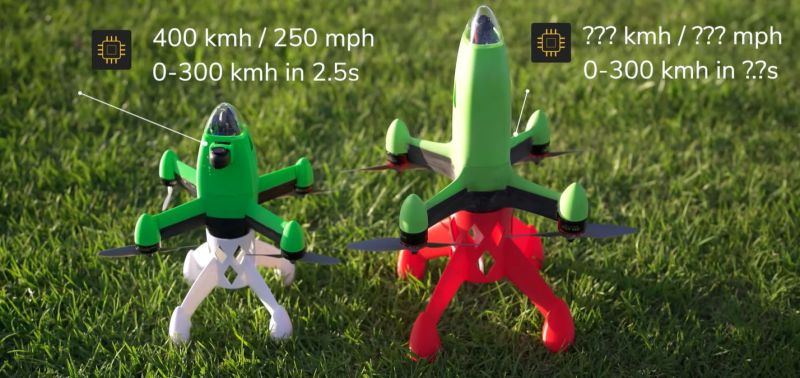Making a quadcopter go fast would seem to be quite simple: just strap on powerful motors, aim the quadcopter roughly at where you want it to go fast, and let ‘er rip. Because of aerodynamics and other pesky physical laws there are a few complications to this, of course, but this didn’t deter [Luke Bell] and his father [Mike Bell] from nailing the Guinness World Record for remote-controlled quadcopters on April 21, 2024. During the official run, a top speed of 480.23 km/h was recorded, making it considerably faster than the first version they made, which hit a measly 400 km/h.
For this second iteration of the ‘got to go fast’ quadcopter, the design was scaled up, with more powerful motors and associated electronics added. Naturally, when you’re pushing brushless motors and their ESCs to their limits, stuff can get a bit hot due to the immense currents flowing through the system. This resulted in a number of battery, wire and other fires. Fortunately, the worrying aspect of in-flight stability got addressed pretty well courtesy of a professional drone trainer, and ultimately the world record attempt went off without a hitch.
An endurance test was also attempted, which reached 7.5 km at 180 km/h, and with the clear canopy in from of the camera removed, visual performance was pretty stunning, while still easily reaching 400 km/h. This might make it the perfect high-speed chase camera system.
Thanks to [Craig] for the tip.















A true beast of a vehicle. Still remember the popularization of quads in the 2010s, such slow and limited ones. We have come a long way.
I remember the first time I heard about a quadcoptor. Someone turned their dead cat into flying cat. I hated that he used the cat as toy.
Orvillecopter?
That divided opinion more than that damn dress.
Remember, a cat is not a toy.
It’s a weapon.
Throw an angry cat (jonesing for nip) in Pootin’s face.
I tried that once, but the cat swung it’s paws round and dug into my arms causing much pain to myself. The cat was fine.
That happens whenever you touch a cat anyhow.
Best to fling it. Hold by tail.
OK look, the problem here is you need a fresh cat. Once you have shown your training model that it may be launched with this activity, it’s too late. Once trained though it’s ok – it’s just that in between stage you need claw kevlar.
I’m glad you call them quads. They are RC quadcopters or quadrotors. I hated it when they suddenly started calling them drones. And then even calling RC helicopters and RC planes drones. A drone is a military aircraft for scouting or killing.
Why do the propellers have two blades and not four?
Fewer blades are more efficient in forward flight.
More blades are more efficient in hover.
Most extreme speed RC planes use 1 bladed props. But that’s mostly so the blade doesn’t get scratched on landing. The engine typically stops on the compression stroke and the blade is clocked to point up.
Obviously these planes have nothing on them that doesn’t make them go faster. So no landing gear, throttles etc.
That is incorrect. Single blade props have aeronomical advantages especially in high speeds. Nothing to do with landing.
I said they were more efficient. But the difference between 1 and 2 is small. Because narrower/higher aspect ratio blades is an advantage and (tip speed/compression limit) is just a function of RPM and diameter. It’s a bunch of tradeoffs.
It absolutely has to do with landing and reuse.
Those loonies spend many hours getting a perfect finish on their blade. A scratch is a lot of work lost.
Not that props turning 28 kRPM+ on one cylinder burning 90%+ nitromethane are long lived.
I’d bet that this quad would be faster if it were powered by nitromethane…
Nitromethane makes everything better.
Always impressive the amount of work (and re-work) that goes into a world record machine. I wonder how long they’ll hold their title. I’m also looking forward to his dad’s video coming out with all the engineering specifics (it doesn’t seem to have hit his channel yet)
> professional drone trainer
A what now?
Invent a buggy, create jobs for whipmakers.
Super cool, but unfortunately light on details. How did he make the nose? What did they learn that caused them to make the nose longer and the tail shorter? What limiting factors are there? I hate when people post cool stuff like this and don’t upload their design for all to learn from.
It’s kind of amazing that a substantial fraction of the battery energy is spent just to turn it into the kinetic energy of that projectile.
I’ll bet this falls afoul of certain laws regarding guided missiles…
This guy is going about things so haphazardly. He thinks battery cell specs apply to an assembled pack an accuses the battery manufacturer of lying about their specs; he puts too much current through wires when he could have easily checked what gauge he needed (and kind of blames the manufacturer for that as well)…dude, this isn’t your first rodeo with drones, learn these basics and do your homework.